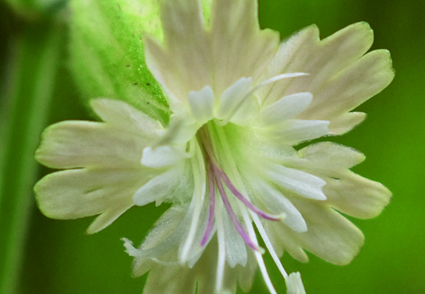Abstract
Silene vagans C.B. Clarke (Caryophyllaceae) has been rediscovered after a lapse of 138 years, which is closely related to Silene khasiana Rohrb., and hitherto been documented solely through its type collection. A detailed floral description of S. vagans, lectotype and epitype designations have been provided here along with its IUCN threat status.
References
- Bentham G. (1839) Enumeration of the Caryophylleæ of the tribe Sileneae, contained in the Indian collections of Dr. Wallich and Mr. Royle. In: Royle JF, editor. Illustrations of the Botany and Other Branches of the Natural History of the Himalayan Mountains. London: Wm H. Allen. pp. 79–81.
- Clarke, C.B. (1888) On the Plants of Kohima and Muneypore. The Journal of the Linnean Society, Botany 25: 1–107. https://doi.org/10.1111/j.1095-8339.1889.tb00793.x
- Edgeworth, M.P. (1875) Caryophylleae. In: Hooker J.D (Eds.) Flora of British India, vol. 1. London: L. Reeve & Co. pp. 212–246.
- IUCN Standards and Petitions Committee (2022) Guidelines for Using the IUCN Red List Categories and Criteria. Version 15.1. Prepared by the Standards and Petitions Committee. [http://www.iucnredlist.org/ documents/RedListGuidelines.pdf]
- Lidén, M. & Oxelman, B. (2023) Flora of Nepal Notulae IV: New species and resurrected Names in Silene. Edinburgh Journal of Botany 80: 1–28. https://doi.org/10.24823/ejb.2023.367
- Linnaeus, C. (1753) Species plantarum, exhibentes plantas rite cognitas, ad genera relatas, cum differentiis specificis, nominibus trivialibus, synonymis selectis, locis natalibus, secundum sytema sexuale digestas, 2 vols. Holmiae: Impensis Laurentii Salvii. 669 pp. https://doi.org/10.5962/bhl.title.59734
- Majumdar, N.C. (1993) Caryophyllaceae: In Sharma, B.D. (eds.) Flora of India Vol. 2. Botanical Survey of India, Calcutta. Pp. 502–595.
- Majumdar, N.C. (2020) Caryophyllaceae. In: Mao, A.A. & Dash, S.S. (Eds.) Flowering plants of India: an annotated checklist (Dicotyledons Vol 1). Botanical Survey of India, Kolkata. Pp. 130–143.
- POWO (2024) Plants of the World Online. Facilitated by the Royal Botanic Gardens, Kew. Published on the Internet: http://www.plantsoftheworldonline.org/ (retrieved 05 May 2024)
- Rajbhandari, K.R., Suzuki, M., Yonekura, K. & Tanaka, N. (2007) Silene khasiana Rohrb. (Caryophyllaceae), a New Record for the Flora of Myanmar. Journal of Japanese Botany 82(6): 349–351.
- Rohrbach, P. (1870) Synopsis der lychnideen. Linnaea 36(3): 258.
- Singh, P., Karthigeyan, K., Lakshminarasimhan, P. & Dash, S.S. (2015) Endemic Vascular Plants of India. Botanical Survey of India, Kolkata. pp. 339.
- Stafleu, F.A. & Cowan, R.S. (1976) Taxonomic literature: A selective guide to botanical publications and collections with dates, commentaries and types, 2nd ed., vols. 1 Regnum Vegetabile 94, 98, 105, 110, 112, 115, 116. Utrecht/Antwerpen:Bohn, Scheltema & Holkema; The Hague/Boston: dr. W. Junk b.v., Publishers. pp. 506. https://doi.org/10.5962/bhl.title.48631
- Turland, N.J., Wiersema, J.H., Barrie, F.R., Greuter, W., Hawksworth, D.L., Herendeen, P.S., Knapp, S., Kusber, W.-H., Li, D.-Z., Marhold, K., May, T.W., McNeill, J., Monro, A.M., Prado, J., Price, M.J. & Smith, G.F. (eds.) (2018) International Code of Nomenclature for algae, fungi, and plants (Shenzhen Code) adopted by the Nineteenth International Botanical Congress Shenzhen, China, July 2017.Regnum Vegetabile 159. Koeltz Botanical Books. https://doi.org/10.12705/Code.2018
- Williams, F.N. (1896) A revision of the genus Silene L. Journal of the Linnean Society 32:1–196. https://doi.org/10.1111/j.1095-8339.1896.tb00695.x
- Zhou, L.H., Lidén, M. & Oxelman, B. (2001) Silene. In: Wu ZY & Raven, P. (Eds.). Flora of China vol. 6. Science Press, and St Louis, Missouri Botanical Garden Press, Beijing. pp. 66–100.


